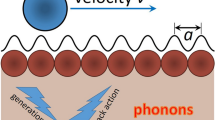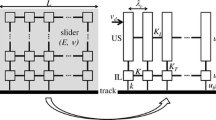Abstract
An elastic layer slides on a rigid flat governed by Coulomb’s friction law. We demonstrate that if the coefficient of friction is high enough, the sliding localizes within stick–slip pulses, which transform into opening waves propagating at intersonic speed in the direction of sliding or, for high Poisson’s ratios, at supersonic speed in the opposite direction. This sliding mode, characterized by marginal frictional dissipation, and similar to carpet fold propagation, may result in inversion of the frictional force direction; at longer time intervals, the system demonstrates stick–slip behavior. The mechanism is described in detail, and a parametric study is presented.




Similar content being viewed by others
Notes
For a single case, the simulations were run also in commercial finite element software ABAQUS, which properly reproduced the results obtained with our software.
References
Adams, G.G.: Steady sliding of two elastic half-spaces with friction reduction due to interface stick-slip. J. Appl. Mech. 65(2), 470–475 (1998)
Adams, G.G.: Radiation of body waves induced by the sliding of an elastic half-space against a rigid surface. J. Appl. Mech. 67(1), 1–5 (2000)
Adams, G.G.: Self-excited oscillations of two elastic half-spaces sliding with a constant coefficient of friction. J. Appl. Mech. 62(4), 867–872 (1995)
Anderson, A., Knapp, R.: Hot spotting in automotive friction systems. Wear 135(2), 319–337 (1990)
Andrews, D.: Rupture propagation with finite stress in antiplane strain. J. Geophys. Res. Solid Earth 81(20), 3575–3582 (1976)
Andrews, D., Ben-Zion, Y.: Wrinkle-like slip pulse on a fault between different materials. J. Geophys. Res. Solid Earth 102(B1), 553–571 (1997)
Barquins, M.: Sliding friction of rubber and Schallamach waves—a review. Mater. Sci. Eng. 73, 45–63 (1985)
Baumberger, T., Caroli, C., Ronsin, O.: Self-healing slip pulses along a gel/glass interface. Phys. Rev. Lett. 88(7), 075509 (2002)
Ben-David, O., Cohen, G., Fineberg, J.: The dynamics of the onset of frictional slip. Science 330(6001), 211 (2010)
Ben-David, O., Fineberg, J.: Static friction coefficient is not a material constant. Phys. Rev. Lett. 106(25), 254301 (2011)
Ben-Zion, Y., Huang, Y.: Dynamic rupture on an interface between a compliant fault zone layer and a stiffer surrounding solid. J. Geophys. Res. Solid Earth 107(B2), ESE-6 (2002)
Besson, J., Foerch, R.: Large scale object-oriented finite element code design. Comput. Methods Appl. Mech. Eng. 142, 165–187 (1997)
Bui, H.D., Oueslati, A.: On the stick-slip waves under unilateral contact and coulomb friction. Ann. Solid Struct. Mech. 1(3–4), 159–172 (2010)
Carpinteri, A., Paggi, M.: Size-scale effects on the friction coefficient. Int. J. Solids Struct. 42(9), 2901–2910 (2005)
Cochard, A., Rice, J.R.: Fault rupture between dissimilar materials: Ill-posedness, regularization, and slip-pulse response. J. Geophys. Res. Solid Earth 105(25), 891 (2000)
Coker, D., Lykotrafitis, G., Needleman, A., Rosakis, A.: Frictional sliding modes along an interface between identical elastic plates subject to shear impact loading. J. Mech. Phys. Solids 53(4), 884–922 (2005)
Coker, D., Rosakis, A.J., Needleman, A.: Dynamic crack growth along a polymer composite–Homalite interface. J. Mech. Phys. Solids 51(3), 425–460 (2003)
Comninou, M., Dundurs, J.: Elastic interface waves involving separation. J. Appl. Mech. 44(2), 222–226 (1977)
Comninou, M., Dundurs, J.: Can two solids slide without slipping? Int. J. Solids Struct. 14(4), 251–260 (1978)
Finite element software Z-set: www.zset-software.com
Francavilla, A., Zienkiewicz, O.C.: A note on numerical computation of elastic contact problems. Int. J. Numer. Meth. Eng. 9, 913–924 (1975)
Freund, L.: Discussion: ”Elastic interface waves involving separation“ (Comninou, M., and Dundurs, J., 1977, ASME J. Appl. Mech., 44, pp. 222–226). J. Appl. Mech. 45(1), 226–227 (1978)
Gent, A.: Friction and wear of highly-elastic solids. Wear 29(1), 111–116 (1974)
Gerde, E., Marder, M.: Friction and fracture. Nature 413(6853), 285–288 (2001)
Heaton, T.H.: Evidence for and implications of self-healing pulses of slip in earthquake rupture. Phys. Earth Planet. Inter. 64(1), 1–20 (1990)
Hilber, H.M., Hughes, T.J., Taylor, R.L.: Improved numerical dissipation for time integration algorithms in structural dynamics. Earthq. Eng. Struct. Dyn. 5(3), 283–292 (1977)
Jean, M.: Frictional contact in collections of rigid or deformable bodies: numerical simulation of geomaterial motions. Mech. Geomater. Interfaces 42, 463–486 (1995)
Kammer, D.S., Radiguet, M., Ampuero, J.P., Molinari, J.F.: Linear elastic fracture mechanics predicts the propagation distance of frictional slip. Tribol. Lett. 57(3), 1–10 (2015)
Kammer, D.S., Yastrebov, V.A., Anciaux, G., Molinari, J.F.: The existence of a critical length scale in regularised friction. J. Mech. Phys. Solids 63, 40–50 (2014)
Kammer, D.S., Yastrebov, V.A., Spijker, P., Molinari, J.F.: On the propagation of slip fronts at frictional interfaces. Tribol. Lett. 48(1), 27–32 (2012)
Kawamura, H., Hatano, T., Kato, N., Biswas, S., Chakrabarti, B.K.: Statistical physics of fracture, friction, and earthquakes. Rev. Mod. Phys. 84(2), 839 (2012)
Lakes, R., Lee, T., Bersie, A., Wang, Y.: Extreme damping in composite materials with negative-stiffness inclusions. Nature 410(6828), 565–567 (2001)
Liu, C., Huang, Y., Rosakis, A.J.: Shear dominated transonic interfacial crack growth in a bimaterial i–ii. asymptotic fields and favorable velocity regimes. J. Mech. Phys. Solids 43(2), 189–206 (1995)
Martins, J., Guimaraes, J., Faria, L.: Dynamic surface solutions in linear elasticity and viscoelasticity with frictional boundary conditions. J. Vib. Acoust. 117(4), 445–451 (1995)
Moirot, F., Nguyen, Q.S., Oueslati, A.: An example of stick-slip and stick-slip-separation waves. Eur. J. Mech. A. Solids 22(1), 107–118 (2003)
Müser, M.H., Wenning, L., Robbins, M.O.: Simple microscopic theory of Amontons’s laws for static friction. Phys. Rev. Lett. 86(7), 1295 (2001)
Palmer, A.C., Rice, J.: The growth of slip surfaces in the progressive failure of over-consolidated clay. In: Proceedings of the Royal Society of London. Series A: Mathematical and physical sciences, vol. 332, pp. 527–548. The Royal Society (1973)
Prakash, V., Clifton, R.J.: Time resolved dynamic friction measurements in pressure-shear. In: K. Ramesh (ed.) Experimental Techniques in the Dynamics of Deformable Solids, AMD-vol. 165, pp. 33–48. ASME, New York (1993)
Ranjith, K., Rice, J.R.: Slip dynamics at an interface between dissimilar materials. J. Mech. Phys. Solids 49(2), 341–361 (2001)
Renardy, M.: Ill-posedness at the boundary for elastic solids sliding under coulomb friction. J. Elast. 27(3), 281 (1992)
Rice, J.R.: Constitutive relations for fault slip and earthquake instabilities. Pure Appl. Geophys. 121(3), 443–475 (1983)
Radiguet, M., Kammer, D.S., Gillet, P., Molinari, J.F.: Survival of heterogeneous stress distributions created by precursory slip at frictional interfaces. Phys. Rev. Lett. 111(16), 164302 (2013)
Schallamach, A.: How does rubber slide? Wear 17(4), 301–312 (1971)
Scholz, C.H.: The Mechanics of Earthquakes and Faulting. Cambridge University Press, Cambridge (2002)
Sørensen, M.R., Jacobsen, K.W., Stoltze, P.: Simulations of atomic-scale sliding friction. Phys. Rev. B 53(4), 2101–2113 (1996)
Supplemental material: animation of formation of the stick-slip and stick-slip-opening pulse
Svetlizky, I., Fineberg, J.: Classical shear cracks drive the onset of dry frictional motion. Nature 509(7499), 205–208 (2014)
Urbakh, M., Klafter, J., Gourdon, D., Israelachvili, J.: The nonlinear nature of friction. Nature 430(6999), 525–528 (2004)
Weertman, J.: Unstable slippage across a fault that separates elastic media of different elastic constants. J. Geophys. Res. Solid Earth 85(B3), 1455–1461 (1980)
Wriggers, P.: Computational Contact Mechanics, 2nd edn. Springer, Berlin (2006)
Xia, K., Rosakis, A.J., Kanamori, H.: Laboratory earthquakes: the sub-rayleigh-to-supershear rupture transition. Science 303(5665), 1859–61 (2004)
Yastrebov, V.A.: Numerical Methods in Contact Mechanics. ISTE/Wiley, New York (2013)
Acknowledgments
The author is grateful to David S. Kammer and Jean-Pierre Vilotte for valuable discussions.
Author information
Authors and Affiliations
Corresponding author
Electronic supplementary material
Below is the link to the electronic supplementary material.
Rights and permissions
About this article
Cite this article
Yastrebov, V.A. Sliding Without Slipping Under Coulomb Friction: Opening Waves and Inversion of Frictional Force. Tribol Lett 62, 1 (2016). https://doi.org/10.1007/s11249-016-0650-6
Received:
Accepted:
Published:
DOI: https://doi.org/10.1007/s11249-016-0650-6




